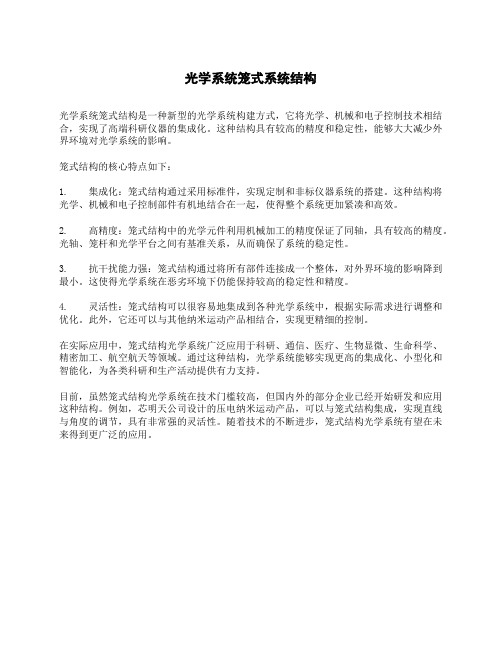光学系统集成
光学专业的就业方向有哪些工作

光学专业的就业方向有哪些工作光学是物理学的一个分支,研究光的产生、传播、控制和应用。
作为一门应用广泛的学科,光学专业的毕业生在许多领域都有就业的机会。
下面是光学专业的几个主要就业方向:1. 光学器件制造和研发光学器件制造和研发是光学专业毕业生的一个重要就业方向。
这些器件包括光学透镜、光纤、光学传感器等,广泛应用于通信、医疗、测量等领域。
光学器件制造和研发工作需要掌握精确的加工和检测技术,以及光学材料的性质和应用知识。
2. 光学仪器与设备的设计和维护光学仪器与设备的设计和维护是光学专业毕业生另一个常见的就业方向。
这些仪器和设备包括激光器、光谱仪、显微镜等,在科研机构、工业企业和医疗机构中广泛使用。
从设计到维护,需要光学专业毕业生具备深厚的光学理论知识和实验技能。
3. 光学系统集成与应用光学系统集成与应用是光学专业就业的另一个热门方向。
可见光和红外光等技术在军事、航天、遥感和安防等领域具有重要应用。
光学专业的毕业生可以参与光学系统的设计、搭建和优化工作,提供整体解决方案,并负责系统的调试和性能测试。
4. 光学传感技术与应用随着科技的进步,光学传感技术在环境监测、生物医学、无损检测等领域起着越来越重要的作用。
光学专业毕业生可以从事光学传感器的设计与制造、传感信号的处理与分析等工作。
光学传感技术还涉及到机器视觉和光学成像等方面,因此需要结合计算机视觉和图像处理知识。
5. 光学通信与光纤传输技术光学通信是现代通信系统的重要组成部分,光纤传输技术也是信息传输领域的关键技术。
光学专业的毕业生可以从事光纤通信系统的设计与维护、光纤光缆的布线与安装等工作。
此外,光纤传感技术在石油、矿山、石化等行业也有广泛应用,光学专业的毕业生在这些领域也有就业机会。
6. 光学教育和科普工作光学专业毕业生还可以从事光学教育和科普工作。
随着光学领域的发展,对光学知识的普及和推广也变得越来越重要。
光学专业毕业生可以担任学校的教师,讲授光学理论和实验,培养光学专业人才。
光学工程师岗位职责范本(2篇)

光学工程师岗位职责范本光学工程师是负责设计和开发各种光学器件和设备的专业人员。
他们在光学设计、光学工程和光学系统中具有广泛的知识和技能。
光学工程师的职责范围包括但不限于以下内容:1. 光学器件设计:光学工程师负责设计和开发各种类型的光学器件,如透镜、棱镜、反射镜和光栅等。
他们需要根据客户需求和项目要求进行光学设计,并使用光学软件和模拟工具来进行光学系统的建模和仿真。
2. 光学系统集成:光学工程师负责将各种光学器件集成到光学系统中,以实现特定的功能和性能。
他们需要进行光学系统的结构设计和光学元件的定位和安装,同时确保各个元件之间的光学匹配和适应性。
3. 光学测试和调试:光学工程师需要进行光学器件和光学系统的测试和调试工作。
他们会使用各种光学测量设备和仪器,如干涉仪、光谱仪和激光干涉仪等来对光学器件和系统进行精确的光学测量和分析。
4. 光学材料选择:光学工程师需要选择适合于光学器件和系统的光学材料。
他们需要了解各种光学材料的光学性能和物理特性,并根据应用需求进行材料的选择和评估。
5. 光学系统性能优化:光学工程师需要对光学系统的性能进行优化和改进。
他们会使用各种光学技术和工具,如衍射、干涉和非线性光学等来改善系统的分辨率、灵敏度和稳定性。
6. 光学技术研究:光学工程师需要进行光学技术的研究和开发工作。
他们会关注光学领域的最新进展和技术趋势,并尝试将新的光学技术应用到实际的工程项目中。
7. 项目管理:光学工程师需要进行项目管理工作,包括制定项目计划、安排资源和控制项目进度。
他们需要与其他工程师和项目团队成员密切合作,确保项目按时完成并达到预期的目标。
8. 技术支持和培训:光学工程师需要向客户和团队成员提供技术支持和培训。
他们会解答客户的技术问题并提供解决方案,同时培训团队成员掌握光学设计和工程的基本知识和技能。
9. 质量控制:光学工程师需要进行质量控制工作,确保光学器件和系统的质量符合相关标准和要求。
光伏发电系统的光学集成与光学器件

光伏发电系统的光学集成与光学器件光伏发电系统是一种利用太阳光将光能转化为电能的可再生能源发电系统。
光学集成与光学器件在光伏发电系统中起着至关重要的作用。
本文将重点介绍光伏发电系统中的光学集成与光学器件,以及它们在系统中的应用。
一、光学集成光学集成是指将光伏发电系统的光学元件、光学器件等组合在一起,形成一个完整的光学系统。
在光学集成中,需要考虑光的折射、反射、衍射等光学现象,以提高光伏发电系统的能量转化效率。
1. 光学元件光学元件是光学集成中的重要组成部分,它们可以对太阳光进行聚焦、分散、衍射等操作。
常见的光学元件有透镜、反射镜、衍射光栅等。
透镜可以将太阳光聚焦到光伏组件上,提高能量转化效率;反射镜可以使太阳光经过多次反射,增加光伏系统的光照强度;衍射光栅可以分散太阳光的波长,使系统能够利用更广泛的光谱。
2. 光学器件光学器件是指用于光学集成中的控制、调节光的设备。
常见的光学器件有光电二极管、光学纤维等。
光电二极管可以将太阳光转化为电能,并输出给光伏发电系统;光学纤维可以传输光信号,将太阳光从光伏组件传输到光电二极管。
二、光学器件光学器件是光伏发电系统中用于光学收集和转换的设备。
光学器件能够最大限度地吸收太阳光,并将其转化为电能。
1. 硅光伏电池硅光伏电池是最常见的光伏器件之一,它利用单晶硅、多晶硅或非晶硅等材料制成。
硅光伏电池通过光电效应将太阳光转化为电能。
硅光伏电池具有高转化效率、稳定性好的特点,已经成为光伏发电系统中最常用的光学器件之一。
2. 光伏透明材料光伏透明材料是一种具有透明性的材料,可以用于光伏发电系统的窗户、阳台等场所,同时收集太阳光。
这种材料利用光学玻璃的特性,使太阳光可以透过材料,并在背面的光伏电池上被吸收和转化。
3. 光伏集中器光伏集中器是一种能集中太阳光到较小面积的光学器件。
它通过使用透镜或反射器等光学元件,将太阳光聚焦到较小的光伏电池上,从而提高能量转化效率。
光伏集中器在大规模光伏电站中有着广泛的应用。
光学工程与集成电路的关系

光学工程与集成电路的关系光学工程与集成电路是两个相互关联且相互促进的领域。
光学工程是研究和应用光学原理和技术来解决工程问题的学科,而集成电路则是将大量的电子元器件集成在一块硅片上,实现电子电路的功能。
在现代科技的发展中,光学工程与集成电路的关系越来越密切,相互之间的融合与协作已经成为科技进步的重要推动力。
光学工程与集成电路在信息传输领域发挥了重要作用。
光学通信作为一种高速、大容量的信息传输方式,得益于光学工程的发展以及集成电路的应用。
集成电路中的光电子器件可以将电信号转换为光信号,而光纤则可以传输这些光信号,实现远距离、高速率的信息传输。
光纤通信系统中需要用到光纤收发器、光电转换器等光学器件,这些器件的研发和制造都离不开光学工程技术的支持。
光学工程与集成电路在光学传感领域有着广泛的应用。
光学传感器是一种将光学信号转换为电信号以实现物理量测量的装置,而集成电路的应用使得光学传感器可以更加高效、精确地实现信号的处理和分析。
例如,在生物医学领域,光学传感器可以用于检测血糖、血氧饱和度等生理参数,而集成电路的应用可以实现对传感器信号的放大、滤波和数字化处理,提高传感器的灵敏度和可靠性。
光学工程与集成电路在光学成像领域也有着广泛的应用。
光学成像技术是利用光学原理和技术,通过光学器件捕捉、记录和处理光信号,实现对目标物体的观测和分析。
集成电路的应用使得光学成像系统可以更加小型化、便携化,并且实现对图像信号的高速、高精度处理。
例如,现代数码相机和手机摄像头中的CCD或CMOS图像传感器,就是一种利用集成电路技术实现的光学成像器件。
光学工程与集成电路在激光技术领域也有着密切的联系。
激光技术是利用受激辐射效应产生的高强度、单色、相干光束,具有高亮度、高直线度和高时空一致性的特点。
集成电路的应用使得激光器件可以更加精确地控制激光的频率、功率和脉冲宽度,满足不同领域对激光的需求。
光纤激光器、半导体激光器等激光器件的研发和制造都离不开光学工程技术和集成电路技术的支持。
光学工程师岗位职责

光学工程师岗位职责光学工程师是一种特殊的工程师,他们专门从事光学相关领域的研究和开发工作。
光学工程师的职责主要包括以下几个方面:1. 光学系统设计光学工程师负责设计、优化和开发光学系统。
他们需要根据客户或项目的需求,确定系统的光学要求,并设计合理的光学结构和元件,选择合适的光学材料和涂层,并运用光学软件进行模拟和分析。
2. 光学性能测试与验证光学工程师需要负责光学系统的性能测试和验证工作。
他们设计和搭建光学测试平台,使用光学测试仪器和设备,对光学系统的各项指标进行测试,如光学分辨能力、聚焦性能、色散、透过率等,确保光学系统的性能符合设计要求。
3. 光学材料研究与开发光学工程师需要不断研究和开发新的光学材料,以满足不同应用领域的需求。
他们会研究光学材料的物理、化学和光学特性,开发新的材料,改进现有材料的性能,以提高光学系统的性能和可靠性。
4. 光学元件制造和加工光学工程师需要与制造工程师密切合作,制定光学元件的生产和加工流程。
他们设计光学元件的形状、尺寸和表面质量,并选择合适的加工工艺和设备,确保光学元件的精度和质量要求。
5. 光学系统集成与调试光学工程师需要负责光学系统的集成和调试工作。
他们需要将各个光学元件组装在一起,调整和校准系统的光学参数,确保系统的各个部分能够正常工作,实现预期的光学功能。
6. 光学系统的优化和改进光学工程师需要不断优化和改进已有的光学系统。
他们会对系统的性能进行分析和评估,找出存在的问题和瓶颈,并提出改进方案,通过调整光学结构、选择更好的光学元件或材料等手段,提高系统的性能和可靠性。
7. 光学技术支持与培训光学工程师还需要提供光学技术支持和培训。
他们会与客户、项目组和其他相关人员进行沟通,解答技术问题,提供技术咨询和建议,并进行光学知识的培训和传授,提升整个团队的光学能力。
综上所述,光学工程师的职责十分多样,涉及光学系统设计、光学性能测试、光学材料研究、光学元件制造、光学系统集成与调试、优化和改进、技术支持等方面。
集成光学电路设计

集成光学电路设计随着信息技术的不断进步,光学电路在通信和计算领域中扮演着越来越重要的角色。
光学电路的高频带宽、低传输损耗以及抗干扰能力强的特点,使其成为当今高速数据传输和处理的理想选择。
本文将重点介绍集成光学电路的设计原理和方法。
一、集成光学电路的概述集成光学电路是指将光学和电路技术相结合,将光学元件、光学传输线、光检测器等组合在一起的器件。
它通过将多个光学组件集成在一张芯片上,实现了传统光学器件的集约化和高度集成。
集成光学电路具有占用空间小、性能可靠、工作频率高等优点,被广泛应用于光通信、生物传感、光子计算等领域。
二、集成光学电路设计的基本原理在进行集成光学电路设计之前,需要了解光学器件和光学波导的原理。
光学器件包括激光器、光检测器、光调制器等,它们分别用于产生、接收和调制光信号。
光学波导是将光信号在芯片表面进行传输的管道,可以分为直波导和曲折波导两种形式。
集成光学电路设计的基本原理是通过将光学器件和光学波导集成在一起,形成特定的光学电路结构。
设计时需要考虑波长选择、传输损耗、耦合效率等因素,并采用合适的设计方法和工艺流程。
常用的设计方法有布拉格光栅、光环等方法,工艺流程包括光子掩膜、刻蚀、镀膜等步骤。
三、集成光学电路设计的步骤1. 确定设计需求:首先需要明确设计的功能和性能要求,包括工作频率、波长范围、传输距离等。
2. 器件选择与设计:根据设计需求,选择合适的光学器件,并将其进行布局和优化设计。
3. 光学电路布局设计:根据器件的相互连接关系,进行光学电路的布局设计。
需要考虑光路长度、耦合效率和互连方式等因素。
4. 电路仿真和优化:使用光学电路仿真软件对电路进行模拟和优化,以获得最佳的工作性能。
5. 工艺制作和调试:根据设计结果,制作相应的光学芯片,并进行调试和测试,以确保其性能与设计要求一致。
四、集成光学电路设计的挑战与前景集成光学电路设计面临着许多挑战,例如器件尺寸缩小、损耗降低、制作工艺复杂等。
共封装光学概念

共封装光学概念共封装光学概念概述共封装光学是一种将多个光学元件集成在一个封装中的技术。
通过共封装,可以将光学元件的功能集成到一个紧凑的封装中,从而实现更高效、更稳定的光学系统。
相关概念封装•封装是将多个元件或部件集成在一个整体中的过程,常用于电子和光学设备。
在共封装光学中,光学元件通过封装技术集成在一个封装中,实现紧凑的光学系统。
光学元件•光学元件是指用于控制、操纵和传输光的器件。
常见的光学元件包括透镜、棱镜、滤光片等。
在共封装光学中,这些元件通过封装集成在一个整体中,形成一个光学系统。
共封装•共封装是指将多个光学元件集成在一个封装中的过程。
通过共封装技术,可以实现多个光学功能在一个紧凑的封装中,从而优化光学系统的性能。
共封装光学系统•共封装光学系统是指利用共封装技术集成的多个光学元件构成的光学系统。
通过共封装,可以实现光学元件之间更紧密的集成,提高系统的可靠性、稳定性和性能。
共封装光学应用•共封装光学技术广泛应用于各个领域,包括通信、传感、医疗等。
例如,在通信领域中,共封装光学器件可以实现高速、稳定的光通信传输;在医疗领域中,共封装光学系统可以用于激光治疗和成像等应用。
相关内容•共封装光学技术的研究与发展–共封装光学技术的发展历程–共封装光学技术的研究进展–共封装光学技术的应用案例•共封装光学系统的优势–更紧凑的封装–提高系统的可靠性和稳定性–优化光学系统的性能•共封装光学技术面临的挑战与解决方案–光学元件的集成方式–光学元件的互相干扰问题–封装材料的选择及封装工艺的优化•共封装光学技术的未来发展趋势–更高集成度的共封装技术–更复杂的光学系统集成–更广泛的应用领域以上就是共封装光学概念及相关内容的简述。
共封装光学技术在光学系统集成方面具有重要作用,随着科技的发展,它将在各个领域展现出更多的应用潜力。
•目前共封装光学技术主要集中在通信领域,尤其是光纤通信。
共封装光学模块可以实现多个功能,如发射、接收、光放大、光路选择等,从而提高光纤通信系统的性能和可靠性。
集成光学芯片技术的发展与应用

集成光学芯片技术的发展与应用随着信息技术的发展和数据通信的日益普及,人们对更高速和更多容量的通信方式和数据存储方式的需求也越来越大。
为此,集成光学芯片技术应运而生,成为满足这些需求的重要途径之一。
本文将介绍集成光学芯片技术的基础概念、发展历程以及相关应用。
一、集成光学芯片技术的基础概念集成光学芯片技术,顾名思义,指将光学芯片集成到一个芯片上的技术,从而实现多个功能的集成化。
这些光学功能包括光源、调制器、耦合器、分束器、滤波器、放大器等。
通过集成,可以实现高速数据传输、节约空间、降低成本等效果。
集成光学芯片是一种微观器件,其结构复杂、制造难度大,需要应用多种高科技生产工艺,包括微影、离子注入、薄膜沉积、光刻等。
此外,由于集成光学芯片直接使用光学信号进行通信,因此对环境的要求也比较高,工作需要在光纤、光源、FPCB等器件的支持下完成。
二、集成光学芯片技术的发展历程集成光学芯片技术的历史可以追溯到上世纪70年代。
1970年美国Bell实验室的Miller首先提出将半导体材料应用于光学器件中的研究。
随着半导体技术的飞速发展,越来越多的光学器件采用半导体材料代替传统的玻璃等材料,这为集成光学芯片技术的发展奠定了基础。
20世纪80年代初,美国AT&T贝尔实验室的Alferness博士和日本NEC公司的Suzuki博士分别研制出了惠普波导和电离DBR 激光器。
这两个发明标志着集成光学芯片技术开始进入实用化阶段。
此外,20世纪90年代以来,欧洲、亚洲等地的许多研究机构也分别推出了各自的集成光学芯片方案。
21世纪,随着科技和资本的全球化,集成光学芯片技术开始进入高速发展期。
在美国,Cisco、Juniper、Alcatel-Lucent等公司相继推出了各自的100G/400G产品;在中国,华为、中兴通讯、烽火通信等国内公司也相继推出了相关产品。
这些产品的推出,不仅使得集成光学芯片技术在通信领域得以广泛应用,同时也进一步促进了集成光学芯片技术的发展。
光学系统集成

>>>定义应用解决任何光学问题的第一步是评估应用。
我想完成什么?对于光学系统,首先确定您需要成像系统还是非成像系统是很重要的,因为每种类型的性能要求不同。
成像系统成像系统将物体的表示传输到检测器,如相机或眼睛。
成像系统的一些例子有:用于检查的电子成像、图像投影系统和中继系统。
成像系统的目标是提供足够的图像质量以使得能够从图像中提取关于对象的期望信息。
注意,对于一个应用来说可能是足够的图像质量在另一个应用中可能被证明是不够的。
成像质量的一些组成部分是分辨率、图像对比度、透视误差、几何误差(如失真)和景深。
非成像系统非成像系统收集、分散、调整大小、聚焦或准直光线。
非成像系统的一些例子是:照明投影、光纤耦合和激光投影。
非成像系统的性能可以通过其吞吐量、场效率、光斑大小(聚焦系统)和角分辨率来量化。
吞吐量是通过透镜系统传输的能量的量度。
场效率是系统适应大探测器面积或源尺寸的能力。
角分辨率通常用于指定两个物体之间所需的最小角距,以便透镜系统分辨它们。
光斑大小用于评估聚焦透镜的性能。
下一步是确定系统的主要参数。
然后,您可以开始为您的应用程序设计表单。
下面是定义的主要参数。
共轭距离从透镜到物体/源的距离(物距)和从透镜到检测器/图像的距离(像距)。
例如,在无限共轭设计中,这些距离中的一个接近无穷大。
共轭大小对象/源的尺寸(对象尺寸)和检测器/图像平面的尺寸(图像尺寸)。
例如,在具有无限共轭的系统中,共轭“大小”可以表示为角度。
数值孔径(NA)和光圈数(f/#)测量透镜系统接收或发射的光锥。
分辨率和光斑大小在成像系统术语中,这是指系统可区分的对象的最小特征。
(该值可以是放大限制或衍射限制)。
在非成像系统中,光斑大小是表征所需性能的一种方式。
无限共轭系统通常用角分辨率来定义。
>>>解决方案形式大多数应用解决方案可以分为三种类型的设计:有限/有限共轭,无限/无限共轭,或无限/有限共轭。
《集成光学第一章》课件

通过优化光波导的结构和材料,可以有效地抑制 反射,提高光的传输效率。
弯曲和扭曲
光波导可以被塑造成各种形状,以适应不同的应 用场景,例如在医疗、军事和科研领域。
光波导的应用
医疗领域
fabs技术可以将光波导植入人体内部,用于 治疗各种疾病,如心脏病、肿瘤等。
军事领域
光波导在军事领域有广泛的应用,例如在导弹制导 、夜视和红外探测等方面。
光信号处理的应用实例
光信号处理在通信领域的应用非常广泛,它可以实现高速、大容量的数据传输和信号处理。例如,利用光干涉技术可以实现 光纤通信中的波长分复用和相干接收;利用光衍射技术可以实现自由空间光通信中的多路复用和超分辨成像;利用光偏振技 术可以实现高速光纤陀螺中的偏振态检测和调制。
光信号处理在生物医学领域也有广泛的应用,它可以实现对生物分子和细胞的检测和分析。例如,利用光干涉技术可以实现 生物传感器中的表面等离子体共振成像;利用光衍射技术可以实现细胞分类和计数;利用光偏振技术可以实现生物分子取向 和构象的检测和分析。
集成光学在能源领域的应用
随着可再生能源的发展,集成光学在能源领域的 应用也将得到拓展,如太阳能光热转换、光子能 量收集等。
集成光学面临的挑战与机遇
技术挑战
集成光学技术需要高精度、高稳定性 的制造和加工技术,同时还需要解决 光子器件之间的耦合问题。
应用挑战
机遇
随着科技的不断进步和应用需求的增 加,集成光学将迎来更多的发展机遇 ,如光子集成电路的商业化应用、生 物医疗领域的光子技术等。
集成光学技术的应用需要与具体领域 的需求相结合,需要解决实际应用中 的问题,如可靠性、稳定性等。
未来集成光学的发展方向
探索新型的光子器件和材料
光学工程师岗位职责

光学工程师岗位职责光学工程师是一种专业技术岗位,负责设计、研发和生产光学器件、仪器和设备。
他们在光学系统、光学测量、激光技术等方面具有专业知识和技能。
下面是光学工程师的一些岗位职责。
1. 光学产品设计:光学工程师负责光学产品的设计,包括光路设计、光学元件选配、机械结构设计等。
他们需要根据产品要求,使用CAD软件进行设计,并对设计结果进行仿真和优化。
2. 光学元件选型:光学工程师需要根据产品设计要求,选择合适的光学元件。
他们需要了解各种光学元件的特性和性能,并与供应商进行合作,选购合适的元件。
3. 光学测试与测量:光学工程师需要进行光学产品的测试和测量。
他们需要使用各种光学测试仪器,如相干干涉仪、衍射仪等,对光学产品的性能进行测试和评估,并根据测试结果进行调整和改进。
4. 光学材料研究:光学工程师需要对光学材料进行研究和评估。
他们需要了解光学材料的特性和性能,并根据产品要求选择合适的材料。
同时,他们还需要对材料进行表征和分析,以评估其适用性和可靠性。
5. 光学系统集成:光学工程师需要将各种光学元件集成到光学系统中。
他们需要进行系统调试和优化,确保系统的性能和稳定性。
同时,他们还需要编写相关的技术文档,记录系统的参数和使用方法。
6. 光学产品制造:光学工程师需要参与光学产品的生产和制造过程。
他们需要与制造工程师合作,制定生产工艺和生产流程,并对产线进行监控和管理,以确保产品的质量和交付时间。
7. 光学技术支持:光学工程师需要为客户和销售团队提供技术支持。
他们需要解答客户的技术问题,制定解决方案,并参与技术交流和展览。
8. 光学研发项目管理:光学工程师可能需要负责光学研发项目的管理。
他们需要制定项目计划和进度,并协调各个团队的工作。
同时,他们还需要评估项目的风险和成本,并制定相应的措施。
9. 光学技术培训:光学工程师需要为团队成员提供培训和指导。
他们需要传授光学技术知识和技能,提高团队成员的专业水平和工作效率。
光学工程师岗位职责

光学工程师岗位职责1.光学系统设计:光学工程师负责设计光学系统,包括光路设计、透镜系统设计以及光学元件选择和定位。
他们需要使用CAD软件进行模拟和仿真,以确保系统能够满足特定的性能要求。
2.光学元件选择和采购:光学工程师负责选择适合特定应用的光学元件,如透镜、滤光片和镜片。
他们需要评估不同供应商的产品,并与供应商进行合作以确保产品的质量和性能。
3.光学系统集成和测试:光学工程师负责将各个光学元件组装和集成成系统,并进行性能测试和验证。
他们需要使用光学测试设备如激光器、光谱仪和干涉仪来评估系统的性能和稳定性。
4.光学系统优化:光学工程师需要对光学系统进行优化,以提高系统的分辨率、灵敏度和稳定性。
他们可能需要进行光学元件的重新选择、系统参数的调整以及光路的优化。
5.故障排除和修复:当光学系统出现问题时,光学工程师负责进行故障排除和修复。
他们需要使用仪器和测试设备来确定问题的根源,并采取相应的纠正措施。
6.光学产品开发:光学工程师可能负责开发新的光学产品。
他们需要与产品经理和设计团队合作,进行市场调研和需求分析,并设计出满足市场需求的创新产品。
7.制定测试标准和流程:光学工程师需要制定光学产品测试的标准和流程,以确保产品的质量和性能符合规定要求。
他们需要编写测试方案和测试报告,并指导测试人员进行测试工作。
8.技术支持和培训:光学工程师需要向其他团队成员提供技术支持和培训,以帮助他们理解和使用光学产品和系统。
他们可能需要撰写使用手册和技术文档,以便用户能够正确操作和维护光学设备。
9.跟踪行业发展和技术趋势:光学工程师需要跟踪光学行业的最新发展和技术趋势,以保持自己的专业知识和技能的更新。
他们可能需要参加行业会议和研讨会,并与其他专业人士进行交流和合作。
总之,光学工程师在光学产品的设计、开发、测试和改进等方面扮演着重要角色。
他们需要具备扎实的光学知识和技能,并且具有分析问题和解决问题的能力。
通过不断学习和追求创新,光学工程师能够为光学行业的发展做出贡献,并推动科学技术的进步。
集成光学的应用及发展前景

集成光学的应用及发展前景集成光学是一种融合了光学、电子学、材料学等多学科的新兴技术,广泛应用于通信、传感、医疗、安防等领域。
本文将分别从应用和发展前景两个方面进行探讨。
应用通信集成光学在通信领域的应用最为广泛,主要体现在光纤通信和光子芯片两个方面。
光纤通信系统光源、耦合器、光电探测器、调制器、可调光衰减器等都可以用集成光学芯片实现,其优点是可以减小体积、提高集成度,从而降低通信系统的成本。
同时,随着大规模数据中心、云计算等近几年的兴起,基于光纤传输的数据传输需求快速增长,驱动着光纤通信技术不断发展。
集成光学芯片也得到了广泛应用,如利用多波长激光器芯片实现WDM技术,解决光纤传输的带宽拓展问题。
传感集成光学在传感领域的应用主要是利用其高灵敏度的特点实现对待测物质的检测。
以光波导传感器为例,它可以提高传感器灵敏度和空间分辨率,可用于生物医学检测、气敏传感等领域。
同时,利用光子晶体腔和纳米光子学技术结合集成光学,可以实现高灵敏度、高选择性的传感器,并广泛应用于有机物、重金属离子、生物分子等的检测应用。
医疗集成光学在医疗领域的应用也十分广泛,如利用光波导芯片制作生物芯片检测系统,基于集成光学的光学相干断层扫描(OCT)成像技术等。
集成光学芯片可以提高设备的精度和灵敏度,使得医学检测设备也出现了跨足集成光学的趋势。
安防随着物联网、云计算等新技术的发展,安防技术也得到了突飞猛进的发展。
集成光学的应用使得安防设备更加高效、精度更高、体积更小,如利用光纤光栅传感器实现对建筑物的远程监测,利用光波导气敏传感器探测瓦斯泄漏等。
发展前景随着科技的不断发展,集成光学技术也在不断创新。
未来随着数字经济的迅速发展、无人驾驶等新兴产业的兴起,集成光学技术进一步融合力学、电器、计算机等学科,其应用领域必将更加拓展。
未来集成光学在以下几个方向有机会得到更大的应用:量子通信:随着金融、政府等领域云计算技术的发展和大规模数据的存储,安全通信需求逐渐增加。
光学工程师岗位职责

光学工程师岗位职责
光学工程师是从事光学工程设计和光学系统开发的专业人才,其工作职责主要包括:
1. 光学系统需求分析:根据客户需求和产品功能要求,进行光学系统分析,包括光学元件和光学结构的选择,光束传输、成像、调节等光学特性的分析,以及光学系统性能的评估和测试。
2. 光学设计:根据光学系统需求分析,进行光学元件的设计,包括光学镜头的设计、成像系统的设计、光学仪器的设计等。
光学设计需要熟练掌握光学计算软件和光学仿真工具,如ZEMAX、Code V、Trace Pro等。
3. 光学结构设计:光学系统的结构设计需要考虑最小化尺寸、重量和成本,减少系统的振动和稳定性等因素,同时应保证光学系统的可靠性和耐用性。
4. 光学系统调试和测试:光学系统调试和测试是光学工程师的核心工作之一,需要利用光学理论和实验方法进行光束传输、光路调节、成像特性分析等,同时需要对光学系统进行性能测试,包括MTF曲线测试、色散测试、增益测试及光谱分析等。
5. 光学零部件选型:根据系统需求,选择合适的光学元件及其他零部件,如光电传感器、光源、光谱仪、精密机械等等。
6. 光学系统集成:光学系统集成需要考虑光学元件的位置、接口、调节方便程度、集成后的系统稳定性等因素。
总的来说,光学工程师需要具备扎实的光学理论基础和丰富的光学工程实战经验,能够熟练掌握光学设计、仿真和测试软件,各
种光学加工工艺,同时具备团队协作能力、良好的沟通能力、批判性思维和创新精神。
光学工程设计高性能光学系统

光学工程设计高性能光学系统光学系统是一种利用光学原理来实现光的采集、传输、处理和应用的系统。
在现代科学和技术领域,光学系统的应用广泛,涉及到光通信、图像传感、测量仪器、激光设备等诸多领域。
为了能够设计出高性能的光学系统,充分发挥光学技术的优势,需考虑以下关键因素。
1. 光源选择光源是光学系统中的核心部件,直接影响到整个系统的性能。
在光学工程设计中,我们需要根据具体应用的需求选择适合的光源。
比如,对于需要高光亮度的应用,可以选择激光器作为光源;而对于需要连续光谱的应用,则可以选择白光LED作为光源。
在选择光源时,还需考虑其稳定性、寿命和功耗等因素。
2. 光学元件设计光学元件是光学系统中起关键作用的部件,包括透镜、棱镜、滤波器等。
在设计光学元件时,需要考虑到折射、反射、散射等光学效应,以及材料的光学性质。
通过优化元件的形状、材料的选择和表面处理等方式,可以改善光学系统的成像质量、光谱分辨率和光损耗等性能指标。
3. 光学系统布局光学系统的布局是指光学元件在系统中的位置和相对排布方式。
合理的布局可以优化系统的光学性能和光路调整的方便性。
在布局设计中,可以采用物理光学的原理,如利用光路折射、反射和平面光学的成像原理,来确定光学元件的相对位置和角度。
此外,还需考虑系统的紧凑性、稳定性和可调整性等方面的要求。
4. 光学系统的光学性能评估为了验证光学系统的性能是否达到设计要求,需要进行光学性能评估。
常用的评估指标包括分辨率、聚焦性能、光学传输损耗、成像质量等。
通过光学性能评估,可以及时发现系统中的问题,为进一步的优化提供依据。
5. 光学系统的系统集成在设计光学系统时,还需考虑到与其他器件的接口和协调。
光学系统的性能不仅取决于光学元件本身,还与其他组成部分的匹配性有关。
因此,需要与机械、电子、软件等相关部门进行合作,实现光学系统的系统集成。
通过协同设计和测试,可以确保整个系统的性能和稳定性。
总结:光学工程设计高性能光学系统需要综合考虑光源的选择、光学元件的设计、光学系统的布局、光学性能的评估和系统集成等关键因素。
我国在光学器件制造及光学系统集成方面的重大突破

我国在光学器件制造及光学系统集成方面的重大突破近些年,咱们国家在光学器件制造和光学系统集成方面可谓是大放异彩,成绩一个比一个亮眼,简直让人目瞪口呆。
这一突破一出,真是刷新了大家对咱们国家科技实力的认知。
咱们常说“国以民为本”,这些科技进步看似遥不可及,实则早已在咱们的生活中悄然发生了变化,不信你看看手机、相机、医疗设备,甚至是交通工具,哪一样不是搭载了光学技术的应用呢?首先说到光学器件,这玩意儿其实就是咱们日常生活中,许多高科技产品背后的“隐形英雄”。
比如你看手机的镜头、数码相机,咱们用的每一张照片都是通过这些光学器件精密打磨出来的。
以前大家觉得这些小东西没啥了不起,可是近几年,随着技术不断突破,咱们的光学器件制造水平,简直不比国际大厂差哪儿去。
你知道吗?曾经咱们还得依赖进口的光学元件,谁想到现在,咱们不光能自己制造,技术水平还稳稳地站在了世界前列。
说起来,光学器件的制造技术就像咱们修理车子一样,需要的精准度和细致程度,差之毫厘,谬以千里。
你别看咱们现在可以制造各种复杂的光学器件,像透镜、棱镜、反射镜啥的,这里面的技术含量可是高得让人咋舌。
比如以前需要精确到纳米级别的光学元件,咱们的光学制造技术已经能够做到,连外企都得感叹:哎,这波操作太猛了。
记得有个光学企业的负责人说,国内的光学镜头技术已经跟国外的巨头站在了同一起跑线,甚至在某些领域,咱们还比他们快了一步。
这是多么让人骄傲的一件事儿!咱们国家的技术人员,就像那种埋头苦干的工匠,精益求精,不敢有丝毫马虎,几年来把光学技术从零散拼凑,做到了系统的整合,真是功夫下得深呀。
光学系统集成,顾名思义,就是把这些看似不相关的光学元件,巧妙地组合起来,让它们在一个系统中协同工作,实现更强大的功能。
这可不是随便玩玩的活儿,它不仅需要高精度的光学器件,更要有超强的设计和集成能力。
你以为这种集成就是“拼拼凑凑”那么简单?那可不,光学系统集成的复杂程度堪比“大杂烩”。
集成光学第一章

4. 从四个方面理解集成光学的概念:
• (a)理论基础:光学和光电子学 • (b)工艺基础:薄膜技术、微电子工艺 • (c) 主要目的:实现光学系统的薄膜化、微 型化和集成化 • (d) 主要应用:光纤通信、光子计算机、光 纤传感、光学信息处理等
集成光学主要应用(一)——光纤通信 • 1.光纤通信
• 光纤传感器可埋入温度高达250℃以上的地 层深处,因此可测量距离达数百公里。可 用于检测地震波、地质板块内部应力、温 度、位移和倾斜、地下流体压力、地下磁 场等地下物理量的动态变化。 • 正是由于光纤传感器具有许多独特优势, 可以解决许多传统传感器无法解决的测量 问题,故自从它问世以来,就被广泛地用 于医疗、交通、电力、机械、石油化工、 航空航天、地质和岩土工程等各个领域。
1.3.3 集成光学国际研究进展
主要集中在理论与器件两个方面:
1. 理论研究热点主要集中在以下两个方面:
1)围绕新型集成光学器件的结构设计、功能模拟与特性 参数的计算等是目前集成光学理论研究的一个热点。 理论上对于集成器件的结构和性能模拟通常使用计算机辅 助设计与数值计算的方法,如传递矩阵法( TMM )、光 束传播法(BPM)、时域有限差分法(FDTD)和有限元 法(FEM)等都有效地用于集成光学器件的模拟与计算, 并用于实现集成器件结构的优化。 设计方法有两类:一是从基本原理入手,设计具有一定功能 的光学器件;二是直接从功能角度出发,以提高器件性能, 减少器件损耗,或者使器件性能具备特色等。
• 光纤传感器具有抗电磁干扰和原子辐射、重量轻、 体积小、绝缘、耐高温、耐腐蚀等众多优异的性 能,能够对应变、压力、温度、振动、声场、折 射率、加速度、电压、气体等各种参数进行精确 测量,能够适应极端恶劣的环境。同时,由于光 纤传输损耗低、频带宽,使得光纤传感器在组网 和传输距离方面,与传统的传感器相比具有无可 比拟的优势。
光学系统笼式系统结构

光学系统笼式系统结构
光学系统笼式结构是一种新型的光学系统构建方式,它将光学、机械和电子控制技术相结合,实现了高端科研仪器的集成化。
这种结构具有较高的精度和稳定性,能够大大减少外界环境对光学系统的影响。
笼式结构的核心特点如下:
1. 集成化:笼式结构通过采用标准件,实现定制和非标仪器系统的搭建。
这种结构将光学、机械和电子控制部件有机地结合在一起,使得整个系统更加紧凑和高效。
2. 高精度:笼式结构中的光学元件利用机械加工的精度保证了同轴,具有较高的精度。
光轴、笼杆和光学平台之间有基准关系,从而确保了系统的稳定性。
3. 抗干扰能力强:笼式结构通过将所有部件连接成一个整体,对外界环境的影响降到最小。
这使得光学系统在恶劣环境下仍能保持较高的稳定性和精度。
4. 灵活性:笼式结构可以很容易地集成到各种光学系统中,根据实际需求进行调整和优化。
此外,它还可以与其他纳米运动产品相结合,实现更精细的控制。
在实际应用中,笼式结构光学系统广泛应用于科研、通信、医疗、生物显微、生命科学、精密加工、航空航天等领域。
通过这种结构,光学系统能够实现更高的集成化、小型化和智能化,为各类科研和生产活动提供有力支持。
目前,虽然笼式结构光学系统在技术门槛较高,但国内外的部分企业已经开始研发和应用这种结构。
例如,芯明天公司设计的压电纳米运动产品,可以与笼式结构集成,实现直线与角度的调节,具有非常强的灵活性。
随着技术的不断进步,笼式结构光学系统有望在未来得到更广泛的应用。
- 1、下载文档前请自行甄别文档内容的完整性,平台不提供额外的编辑、内容补充、找答案等附加服务。
- 2、"仅部分预览"的文档,不可在线预览部分如存在完整性等问题,可反馈申请退款(可完整预览的文档不适用该条件!)。
- 3、如文档侵犯您的权益,请联系客服反馈,我们会尽快为您处理(人工客服工作时间:9:00-18:30)。
Integration of Optical SystemsThese application notes are relevant to both off-the-shelf and custom integration for imaging, as well as non-imaging systems. Please feel free to discuss any of the content in these notes or any other integration questions with our Applications Engineers.DEFINING THE APPLICATIONThe first step to solving any optical problem is to assess the application. What am I trying to accomplish? For an optical system it is important to first determine whether you need an imaging system or non-imaging system because the performance requirements are different for each type.Imaging SystemImaging systems transfer a representation of the object to a detector, such as a camera or your eye. Some examples of imaging systems are: electronic imaging for inspection, image projection systems and relay systems. The goal of an imaging system is to provide sufficient image quality to enable extraction of desired information about the object from the image. Note that what may be adequate image quality for one application may prove inadequate in another. Some of the components of imaging quality are resolution, image contrast, perspective errors, geometric errors (such as distortion) and depth of field.Non-Imaging SystemNon-imaging systems collect, disperse, resize, focus, or collimate light. Some examples of non-imaging systems are: illumination projection, fiber coupling and laser projection. The performance of a non-imaging system can be quantified by its throughput, field efficiency, spot size (focusing systems) and angular resolution. Throughput is a measure of the energy transmitted through the lens system. Field efficiency is the system's ability to accommodate a large detector area or source size. Angular resolution is generally used to specify the minimum angular separation needed between two objects in order for the lens system to resolve them. Spot size is used to evaluate a focusing lens's performance.The next step is to determine the primary parameters of your system. Then, you can begin a design form for your application. Below are the primary parameters defined.Conjugate DistancesThe distance from the lens to the object/source (object distance) and the distance from the lens to the detector/image (image distance). For example, in an infinite conjugate design one of these distances approaches infinity.Conjugate SizesThe size of the object/source (object size) and the size of the detector/image plane (image size). For example, in systems with an infinite conjugate, the conjugate "size" can be expressed as an angle.Numerical Aperture (NA) and f-Number (f/#)A measure of the cone of light accepted or emitted by the lens system.Resolution and Spot SizeIn imaging system terms, this refers to the smallest feature of an object distinguishable by the system. (This value may be magnification limited or diffraction limited). In non-imaging systems, spot size is a way to characterize the performance needed. Infinite conjugate systems are often defined in terms of angular resolution.SOLUTION FORMSMost application solutions can be divided into three types of designs: Finite/Finite Conjugate, Infinite/Infinite Conjugate, or Infinite/Finite Conjugate. A finite/finite conjugate design is one in which light from a source (not at infinity) is focused down to a spot. Most video lenses, which take the image of an object at a finite distance away and focus it onto a sensor, are designed for this scenario. An infinite/infinite conjugate application takes incoming collimated (parallel) light, changes the beam diameter according to the magnification, and emits the collimated light. An infinite/finite conjugate design combines these two concepts by focusing a source placed at infinity down to a small spot.In order to choose the appropriate design it is best to begin with the "paraxial solution."A paraxial solution allows a designer to approximate first order properties such as conjugate distances, image and object heights, magnification, etc. Paraxial calculations utilize paraxial elements - theoretically perfect lenses that do not introduce system aberrations associated with lens thickness, radius of curvature, glass type and dispersion effects. Note: the only specifications for a paraxial lens are its position relative to the image and object plane, lens diameter, and focal length. After finding the paraxial solution you can begin to select the best real lens solution for your application, making allowances for lens thickness, dispersion effects, etc. in your calculations. Because the calculations for real lens solutions can be long and tedious, we offer an optical design software, OLIVE - Optical Layout Including Video Elements, which is intended to help the novice and non-optical engineer integrate real lenses into their applications.Each design form below illustrates different lens combinations and the performance associated with them. Please note that you are not limited to just these lens combinations. Below is a list of variables used for the solution examples.Description of VariablesH i , H o Image and object height, respectively. This represents HALF of the actual full image and object size. In afocal systems, this represents half of the full beam waist.I , O Image and object distance measured from the lens closest to the image and objectrespectively.F i , F oFocal length of the lens closest to the image and object, respectively.F Effective focal length of the entire lens system.M Magnification is the system's ability to produce an enlarged/reduced image or projection of an object.d Distance between two elements.?FULL angle of the cone of light accepted or emitted by a lens system (closely linked to numerical aperture).a i , a oAngular HALF field of view in infinite conjugate systems.TP Throughput is the system's ability to transfer light.f/#f/# is the lens' ability to focus light.D Diameter of the LensSign ConventionPositive Values:The following quantities are expressed as positive values: heights above the optical axis, distances measured to the right of a reference point, focal length of focusing lenses, and angles that are measured counter clockwise from the optical axis. Negative Value: The opposites of the above quantities are expressed as negative values.(i.e. - While height measured above the optical axis is expressed as a positive quantity, height measured below the optical axis is expressed as a negative quantity). Reference Point for Equations Given: Lens PositionChart LegendThe ctiteria used to evaluate each type of lens under different configurations is as follows:• = poor to ••••• = excellentLow f/#: Lens' ability to work at low f/# (i.e., large incoming light diameter or high NA). Low f/# applications should use lenses with (•••••) rating.Polychromatic:Lens' ability to hold performance with white light illumination (as opposed to monochromatic sources such as lasers or some LEDs). Applications with broadband illumin ation and no filtering should use lenses with (•••••) rating.Field Efficiency: Lens' ability to accommodate a large sensor (image), source (object), or angular field of view (in afocal systems). Applications with large image/objects should use lenses with (•••••) rating.Cost: This is a comparison of the cost of each type of configuration (i.e takes into consideration the number of elements in that configuration). Low cost - $, High cost - $$$$$CASE 1: FINITE/FINITE CONJUGATESCommon Applications: Electronic Imaging, Relay Systems and Image ProjectionSingle Element:The simplest form of a finite/finite conjugate system is one with a single element in which the effective focal length of the system is equal to the focal length of the single lens. Some advantages of this design are its cost effectiveness and its simplicity of design. The following equations determine the first order optical properties of a single lens.Two Element:You can combine elements to achieve different effective focal lengths while increasing the image performance of the system drastically. The design becomes a bit more complex, though one method of simplifying it is to place the object at the focal point of the object lens and the image at the focal point of the image lens.Real Lens Solutions: For imaging applications, achromats are typically used in order to yield better image quality with a single element. Singlets (PCX or DCX) are typically used in illumination based relays which do not require high resolution.Single Element | Two ElementLens Type Low f/#Polychromatic FieldEfficiency Cost SuggestedApplicationsPlano-Convex (PCX) ••••$$ use in pairs Double-Convex (DCX) ••••••$ singleelement Achromat ••••••••••••$$$$ use in pairs Hastings •••••••••••••$$$$$ use in pairs Steinheil •••••••••••••••$$$ singleelementCASE 2: INFINITE/INFINITE CONJUGATESCommon Applications: Telescopes and Beam ExpandersOne Positive Element and One Negative Element:Most high power laser applications utilize this form for beam expansion. One advantage of this form is that system length is greatly reduced while an erect image is maintained.Two Positive Elements: Using two positive elements yields an intermediate image which is useful for applications requiring use of a crosshair or other type of reticle. Using two positive elements will result in a negative magnification such that a prism erector or intermediate relay lens would be needed for erect image viewing.Real Lens Solutions:Achromatic lenses are typically used for improving field efficiency.Note: Eyepiece designs can be used as the imaging lens to improve performance.One Positive, One Negative Two PositiveEfficiency Applications Plano-Convex (PCX) •••••$$ imaging,illumination Double-Convex (DCX) ••••$$ -Achromat ••••••••••••$$$$ imaging,illumination Hastings ••••••••••••••$$$$$ imaging,illumination Steinheil ••••••••••$$$$$ -CASE 3: INFINITE/FINITE CONJUGATESCommon Applications:Autocollimators, Light Detection and Infinity-Corrected ObjectivesSingle Element: Except in the case of infinity-corrected objectives, this solution generally does not require use of more than one element and the image can be found at the focal point of the lens. An important function of an infinite/finite conjugate system is the throughput (flux per unit radiance or luminance) seen by the detector. The following paraxial equations can be used to estimate the amount of throughput generated by the lens system.Real Lens Solutions:A singlet will provide sufficient results for most applications that focus an extended light source upon a detector.Efficiency Applications Plano-Convex (PCX) •••••$ detector,illumination Double-Convex (DCX) ••••$ —Achromat ••••••••••••$$ imaging Hastings •••••••••••••••$$$ imaging Steinheil •••••••••••$$$ —APPLICATION EXAMPLE: FINITE/FINITE CONJUGATEA typical Finite/Finite Conjugate application is wire bond inspection. First we will define the necessary parameters. Field of view (object size) required is 5mm. The imaging sensor is a ½" format CCD with a horizontal sensing distance of 6.4mm. Unfortunately, due to the size of the probes, the object distance must be 50mm or greater. Neither the image nor the object distance is at infinity, so the Finite/Finite Conjugate design form can be used to solve this example.The next step is to find a real lens that solves your application requirements. Based on our solution above we need a lens with a focal length of 28.07mm. Since this is an imaging application, achromats can be used to improve image quality. A good lens choice would be to use a 25mm diameter achromat with 30mm focal length (#45-211 Achromatic Doublet), given that a focal length of 28.07mm is not available off-the-shelf. Inserting this lens into OLIVE, we can easily find the actual object and image distance (i.e. the real lens solution) that we must position the lens at. Below is a diagram of the paraxial lens solution. The chart below summarizes the differences between the paraxial and real lens solutions. The paraxial equations steered us in the right direction and helped narrow down the lens choices, while inserting the real lens gave precise answers for the image and object distance.Parameter Paraxial Solution Real Lens Solution Real Lens Solution Lens System Single Achromat Single Achromat Achromat Pair Effective Focal Length 30mm 30mm 75 / 100mm Magnification 1.28X 1.28X 1.28XObject Distance 53.44mm 56.2mm 74.81mmParaxial Image Distance 68.4mm 60.460mm 96.08mmBest Focus Location unknown 44.404mm 88.28mmDue to aberrations associated with real lenses, the OLIVE software gives a minimum spot size of 0.9mm (see Figure 3) for the single 25mm Dia x 30mm FL achromat in the given configuration. Inserting an achromat pair (#55-280) reduces this spot size to 0.3mm which equates to an increase in resolution (reference Figures 2 and 4). Using OLIVE, an aperture can be inserted between the two achromats for a further increase in performance. This is a prime example of how paraxial knowledge along with software such as OLIVE can help to improve your imaging solutions.MECHANICAL INTEGRATIONOnce optical layout is defined it needs to be integrated into a mechanical housing. In doing so, lens spacing must be maintained despite the effects of sag. Once sag for each surface is determined, spacers and seats can be designed to yield appropriatecenter-to-center lens spacing.SagSag is the distance between the edge of a mount and the vertex of a surface (see illustration below). Sag only exists when surfaces have curvature, as the inner diameter of the spacer or seat determines vertex location.Retainer vs. SpacerThe three common lens-mounting techniques are: retainer rings, spacers and a combination thereof. Retainers generally offer tighter control over the elements' position, tilt and centering because the lens sits on a counterbored seat. Retainers can be costly and are sometimes impractical in small assemblies. Spacers are ideal for small assemblies and are cost effective though they yield looser lens spacing tolerance than with retainer rings.Focusing/AdjustmentAll optical designs require some focusing or adjustment. Common focusing techniques are moving the image (sensor), object or lens elements.TolerancesTolerances affect the yield of a production lens. Because each dimension has an associated tolerance, yield is less than 100%. The conventional method of stacking up tolerances tends to result in over-toleranced (and over priced) designs. Instead, by combining each probability curve, one can accurately predict the % yield of a lens. Understanding the probabilistic nature of tolerancing is vital to reducing the per piece cost in large production runs.TESTING AND EVALUATIONOnce a system is assembled, its parameters must be quantified to determine whether the application requirements have been met. During prototyping, slight alterations to the original design are typical to accommodate component limitations.Fundamental ParametersEvery application has first order requirements (e.g. conjugate distances, magnification). Paraxial calculations, which do not take into account the properties of theglass(dispersion, thickness, etc.), may need adjustment to meet first order requirements. Design PerformanceSince paraxial calculations do not indicate real world performance, image quality of the assembly should be tested. Various targets exist for determining the quality of imaging systems. Non-imaging systems may require more involved interferometric instruments for testing.Resolution and Contrast: can be measured using the USAF and EIA Grayscale targets respectively. Perspective errors can be determined by measuring magnification change across the depth of field.Throughput:can be measured as power with a photodiode. A CCD analyzes spot size and beam profiling. Collimator measures angular resolution.RULES OF THUMB:Test with Application in Mind:Do not test performance beyond what the application requires. Test only critical parameters to reduce costs.Cost Associated with Testing: Testing adds significant costs. High volume production warrants extra testing resources though low-quantity production does not justify it.Visual Tests:Tests based on a visual observation are subjective and lack repeatability. Because the human eye can extrapolate missing information, visual tests need to be desensitized to human error (e.g. utilize a line profile function across the USAF resolution target to determine the actual Group and Element that are resolvable.)。
